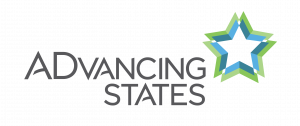Nursing Facility Transitions
UTAH
Identified Problems with the State's Long-Term Care System
- Lack of skills and knowledge among people living in nursing facilities who want to move back into the community and who are often isolated.
- Inadequate infrastructure and fragmentation of community services and supports necessary to support transitioning residents.
- Lack of coordination and knowledge among the people who need to be integral players in reintegrating transitioning consumers into the community.
Perceived Strengths
- The partnership of the six state Independent Living Centers (ILCs) provides coverage to transition consumers statewide.
- Each ILC has expertise and knowledge of its local community services network and barriers that need to be overcome.
Primary Focus of Grant Activities
- Transition 260 people with primarily physical disabilities from nursing facilities to community settings.
- Support transitioning consumers with skills training through peer mentorship.
- Improve the community support infrastructure statewide.
Goals, Objectives, and Activities
Overall Goal. Transition 260 people from nursing facilities to community living through partnership among the state's six ILCs, with the ability to address and mitigate local barriers to transition, thus improving the community services and supports infrastructure.
Goal. Provide skills training statewide through a network of ILCs to 260 long-term care residents of nursing facilities.
Objectives/Activities
- Use local level experience to guide and customize outreach efforts to identify residents who want to transition.
- Establish a peer network of volunteer mentors in each independent living service area comprising consumers who have successfully transitioned to community living.
- Use the peer role mentoring model to provide skills training both before the consumer's transition to community living and afterward during follow up.
Goal. Organize six local (voluntary) advocacy alliances to facilitate communications between state, local and advocacy organizations.
Objectives/Activities
- The advocacy alliances will comprise the peer mentors, ILC staff, and local community services organizations.
- The advocacy alliances will create a forum to share information and foster communication among participants in the transition project, and explore creative approaches to community integration for consumers.
- A Transition Resource Guide, compiled and updated annually by the Association for Independent Living of Utah, will be a compendium of information gleaned through the six local advocacy alliances and will aid the ILCs in promoting a "no wrong door" approach.
Goal. Develop a single coordinating entity through which agencies can disseminate information to promote community integration.
Objectives/Activities
- The state's ILCs can function as a coordinating entity through which a number of agencies can disseminate information, share view points, recruit membership, promote community integration, and problem solve difficult issues and scenarios.
- Although outreach activities will be locally based through the six ILC partners, the grant will help procure the resources and personnel to coordinate such efforts both on the state level and in each of the individual ILCs.
Key Activities and Products
- Provide skill training statewide through a network of ILCs to 260 long-term care residents living in 78 nursing homes, both while they are in the nursing home and throughout their transition to community living.
- Establish a peer network of volunteer mentors in each ILC service area comprising consumers who have successfully transitioned to community living.
- Organize six local advocacy alliances, facilitating open communication between state, local, and advocacy organizations.
- Develop a single coordinating entity through which agencies can disseminate information to promote community integration.
- Develop a Transition Guide that presents lessons learned from the six alliances that facilitate transitions under the grant.
Consumer Partners and Consumer Involvement in Planning Activities
Consumers with disabilities comprise 74 percent of Utah ILC's staff, including the Director. Utah ILC was the lead organization in writing the Independent Partnership Grant application.
Consumer Partners and Consumer Involvement in Implementation Activities
- Utah ILC will contract with the five other state ILCs to conduct transition services for consumers transitioning into community living. By charter, every ILC staffing must comprise at least 51 percent people with disabilities.
- The Transition Steering Committee is an oversight/advisory committee consisting of six CIL directors. The group will also receive feedback for the local advocacy alliances and will advocate for change at the state level.
Public Partners
- Utah Department of Health, Division of Adult and Aging Services.
- Utah Department of Community and Economic Development.
- Utah Department of Workforce Services.
- Utah Department of Human Services.
Private Partners and Subcontractors
- Options for Independence, Logan, UT ILC.
- Tri-County ILC, Ogden, UT.
- Central Utah CIL, Provo, UT.
- Active Re-Entry, Price, UT ILC.
- Red Rock Center for Independence, St. George, UT ILC.
- Association for Independent Living of Utah.
- Utah Work Incentive Coalition.
Public and Private Partnership Development/Involvement in the Planning Phase
Public Partners
None were involved.
Private Partners
Directors of the state's six ILCs provided input in the writing of the Independent Partnerships Grant application.
Public and Private Partnership Development/Involvement in Implementation
Public Partners
- Utah Department of Health manages the state's 1915c Medicaid waivers and will partner with the ILCs to provide training to the ILC transition coordinators about the services available through the waivers and accessing the waivers. The Utah Department of Health will also have regular communication with the grant's Transition Steering Committee to provide cross-disability advice and advocacy support.
- The Division of Aging and Adult Services will provide training to ILC transition coordinators on Protection and Advocacy services.
- A coordinated effort will be undertaken with the Utah Department of Workforce Services to increase the pool of individuals wanting work as or training to become a personal attendant.
- The Utah Department of Community and Economic Development will provide training for ILC staff on locating and accessing affordable housing for transitioning individuals.
Private Partners
- Each ILC will recruit peer mentor volunteers, consumers with disabilities who either have successfully transitioned into community living from nursing facilities and/or who use home and community services. Each ILC will also provide staff to act as transition coordinators and will identify and transition a proportion of the grant's goal to transition 260 individuals.
- Six Advocacy Alliances, one created by each partner ILC, will include, as yet unspecified, local services and support organizations and advocacy organizations. These Advocacy Alliances will target developing infrastructure through gathering information on resource allocation, housing, transportation, healthcare, and employment issues.
- The Association for Independent Living of Utah will compile an annual Transition Resource Guide.
- The Utah Work Incentive Coalition will provide training to ILC staff on Medicaid employment incentives such as the Ticket to Work program.
Existing Partnerships That Will Be Utilized to Leverage or Support Project Activities
The Utah Department of Human Services, which is implementing the state's Real Choice Systems Change Grant, will coordinate with the Transition Steering Committee to avoid duplication of efforts. For example, this grant will train transitioning individuals in recruiting and training attendants, while the Real Choice Systems Change Grant will develop attendant training programs.
Oversight/Advisory Committee
The Transition Steering Committee is an oversight/advisory committee consisting of six CIL directors.
Formative Learning and Evaluation Activities
The local volunteer peer mentors will help to identify and address individual needs as they support transitioning consumers and will be able to share this knowledge with the ILCs and the Transition Steering Committee to create a better, sustainable transitioning model. The peer mentors will be identified from all areas of the state and will form an informal network.
Evidence of Enduring Change/Sustainability
- The six staff members hired to coordinate grant activities will gradually teach and transfer their responsibilities to permanent local ILC staff to guarantee the program can continue after grant funding has ended.
- The grant will develop a network of 18 volunteer peer mentors to support transitioning consumers, who will continue to work with ILCs after the grant. The peer mentors will be volunteers. Each CIL will make an individual decision based on their existing policies to reimburse or not for mileage and other incidental expenses.
- Six public/private Advocacy Alliances developed in each of the ILC regions will continue to share information and foster more cooperation among the components of the long term care system.
- The Transition Resource Guide, compiled and updated annually by the Association for Independent Living of Utah, will be a compendium of information gleaned through the six local Advocacy Alliances and will aid the ILCs in promoting a "no wrong door" approach.
Geographic Focus
Statewide.

